Some characters you like and you don’t even know why.
There’s no good reason I should have liked Mr. Terrific as a kid. No super powers, a bad costume, a hopelessly old-fashioned name, and yet, for some reason, he’s always been a sentimental favorite, even though by the time I was first introduced to the character, he was already little more than a MacGuffin, the victim in a murder mystery whodunit in one of the annual summertime JLA/JSA team-ups in the pages of JUSTICE LEAGUE OF AMERICA. More on that in a bit — for now, let’s start at the beginning of the career one of the most curiously underdeveloped yet still somehow beloved characters in the DC pantheon: Terry Sloane, otherwise known as Mr. Terrific.
Mr. Terrific first appeared in the pages of SENSATION COMICS #1 (January 1942), a comic book much better known for the other character introduced in those pages: Wonder Woman. Created by writer Charles Reizenstein (who had also created Dr. Mid-Nite for All-American Comics the year previous) and artist Hal Sharp, the first Mr. Terrific feature, it must be admitted, may have been the least dramatic origin story for a superhero ever. How did Terry Sloane get so intellectually and athletically gifted? Born that way.
We first meet young master Sloane at the age of 10, when the boy genius is already selling a design for a new and improved seaplane to the United States Navy.
After the meeting, when a couple of spies try to steal the plans, young Terry leaps into action, roughing up the thugs and saving the plans. As it turns out, “Athletics is another one of [his] hobbies.”
In short order, Terry graduates high school at 11 and college at 12, becomes a champion college athlete, and turns his attention to the business world, becoming rich and successful before most men have even finished their education. Rather than enjoying his success, however, Terry Sloane has become bored by it, and with no challenges left and no worlds left to conquer, he decides to end it all, and is about to drive his car off the side of a bridge. Before he can, he sees a young woman about to commit the same suicidal act herself, jumping off the bridge, and Terry leaps into action, diving after her into the river below and dragging the drowning girl to safety.
The woman tells Terry her story, how her young brother and his friends (a group of tough young tykes calling themselves “the Purple Dagger Gang”) had fallen in with a gangster by the name of “Big Shot,” and that she dared not go to the police, since Big Shot had threatened to pin all his crimes on her brother if she did.
Terry decides to try to help the boy before doing himself in, and soon pays a visit to the boys’ clubhouse, dressed in a bizarre green and red costume with “Fair Play” stitched across his midsection. In an attempt to win the boys’ admiration and respect, he takes on Big Shot’s gang singlehandedly and mops the floor with them.
Then he drags Big Shot outside to go mano-a-mano and once again is victorious.
And finally, to prove that he’s got Big Shot beaten in both brains and brawn, he vanquishes the gangster with a vicious math problem:
Defeated by simple addition, Big Shot flees the scene, and before long the Purple Dagger gang has become the Fair Play Club, complete with a plush new clubhouse paid for by Terry Sloane’s cash. As for the new boss of the club, he’s given his name by the boys themselves: “Mr. Terrific.”
Having found the purpose his otherwise perfect life lacked, Terry elected to continue his career as Mr. Terrific, instead of steering his Studebaker into the Potomac.
In Mr, Terrific’s solo adventures, at least the ones I’ve been able to read, he, like most of his mystery-man counterparts contended primarily with gangsters, crooks and blackmailers, and not so much costumed villains. In SENSATION COMICS #3 (again by Reizebnstein and Sharp), for example, Mr. Terrific was contending with the would-be coup of a South American country attempting to ask the U.S. for humanitarian aid. When El Presidente is drugged and made to forget his identity, Mr. Terrific whips up a concoction to restore his memory.
However, it appears all is lost when it’s revealed that the would-be conspirators destroyed El Presidente’s aid report. Not to worry, though: they hadn’t counted on Mr. Terrific’s photographic memory (and impressive typing speed, for that matter):
Probably the first and last time that “Get me a typewriter!” was a superhero’s battle cry.
The best Mr. Terrific solo stories played up Mr. Terrific’s gifts as “the Man of 1,000 Talents,” such as in the story by Reizenstein and Sharp that appeared in SENSATION COMICS #2 (February 1942). Here local mobsters try to shut down the benefit show for a local boys’ home so they can foreclose on it, even going so far as to drug all the performers so they can’t put on the show. Luckily for the boys’ home, Mr. Terrific can do anything, as he proves in short order (and in a series of disguises, to boot — he’s also a master of disguise, don’t you know) by playing the classical violin…
…boxing the number-one contender…
…and being fired from a cannon:
Mr. Terrific tops off the evening by yanking the head mobster out of the audience via trapeze and forcing him to tear up the mortgage to the boys’ home. Encore!
There’s also an odd wistfulness about Mr. Terrific, as in the story’s final panels, in which Terry Sloane discusses the adventure with his friend Wanda, the woman he rescued from suicide in his debut appearance (who in an uncharacteristic detail is privy to Mr. Terrific’s secret identity) and makes this kinda bittersweet admission:
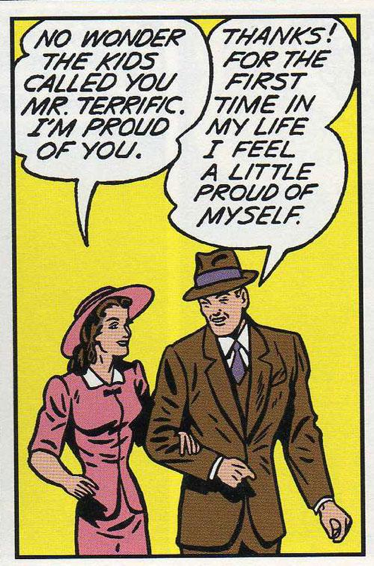 No wonder I like Mr. Terrific. That kind of insecurity I can relate to.
No wonder I like Mr. Terrific. That kind of insecurity I can relate to.
Come on back next week as we look at Mr. Terrific’s short-lived original tenure in the Justice Society of America, his somewhat more respectable second JSA run and the details of his tragic demise.

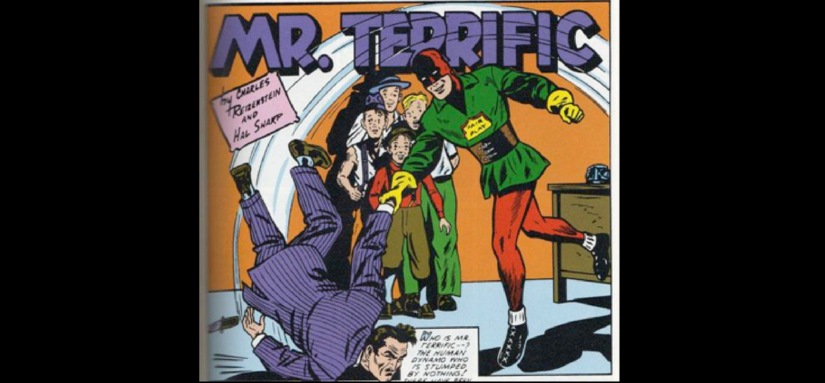
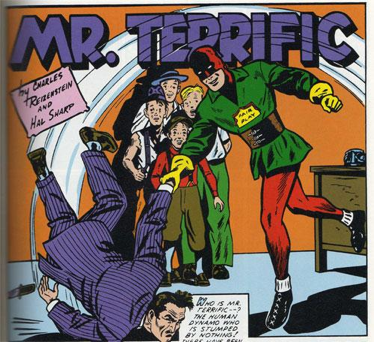
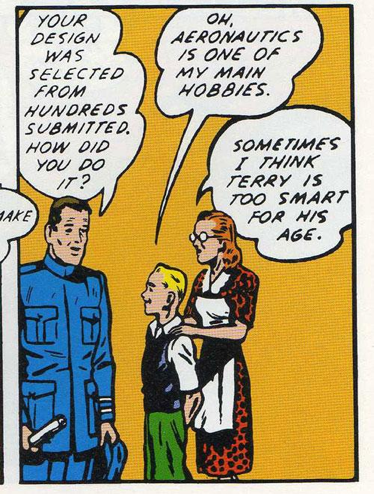
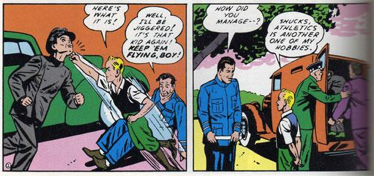

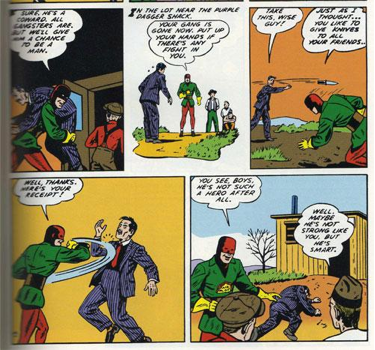




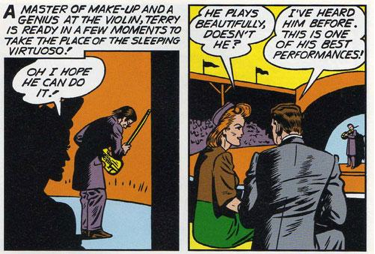


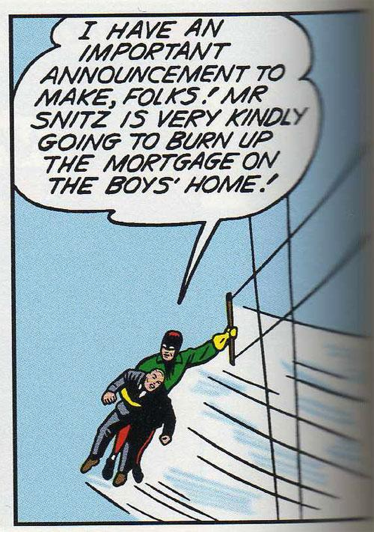
Comments are closed.